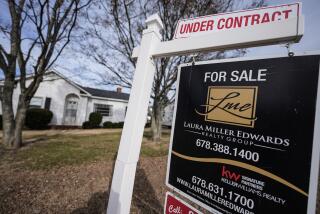Brokers Have a ‘Lock’ on Deals
- Share via
Question: In a recent column, you said that many mortgage brokers lock borrowers’ interest rates at their own risk rather than at the lender’s risk. Given that brokers have no special expertise in forecasting rates, this makes no sense.
Answer: Brokers don’t have to have the ability to forecast rates, and they don’t need it. Because of the way the market works, the broker wins if interest rates don’t change between the lock date and the closing date or if rates decline. Brokers lose only if rates increase appreciably during the lock period.
Consider a borrower who wants rate protection for 60 days. His mortgage broker shops the market for the best wholesale prices. The price on a loan delivered today (the “float” price) is 8%, plus one point (each point is 1% of the loan). The price on a loan delivered within 60 days (the 60-day lock price) is 8% plus 1 1/2 points. The broker adds a markup of, say, 1 1/2 points to the 60-day lock price, making the final cost 8% plus three points.
The difference of half a point between the float price and the 60-day lock price reflects the lender’s “lock-jumping” risk. If interest rates increase during the 60-day period, the lender is nevertheless committed to delivering the lock terms. But if interest rates decline, the borrower can walk away.
Because the borrower wants the rate protection, the mortgage broker provides it. The borrower is guaranteed that the loan will close at 8% plus three points. If the broker locks the loan with the lender, the lender gets 1 1/2 points and the broker makes 1 1/2 points.
Alternatively, the broker may lock the loan at his own risk. If so, and if interest rates don’t change during the 60 days, the loan will be delivered to the lender at the float price, or 8% plus one point. The borrower pays three points, as before, but the broker makes two points instead of 1 1/2.
If interest rates increase during the 60-day period, the broker could lose the extra profit and even the markup. If the float price after 60 days turns out to be 8% plus three points, for example, the broker will make nothing on the deal.
If interest rates decline, the broker will make more than two points, assuming that the borrower stays with the deal. If the borrower threatens to walk, the broker will be forced to share some of the benefit. For this reason, gains from rate declines don’t fully offset losses from rate increases.
Brokers who lock at their own risk believe that the profits they earn in a stable market will be greater than their losses from market fluctuations. Through most of the 1990s, losses have been small.
Is the practice kosher? Brokers believe it is because the borrower is protected. Brokers absorb the loss if interest rates go against them. But it is fair-weather protection that disappears when the consumer needs it most.
For example, in January to March 1980, mortgage rates jumped from 12.88% to 15.28%. A broker who locked for 60 days at 12.88% would have to pay a lender about 15 points to accept a loan with that rate in a 15.28% market. The broker would either go out of business or deny that a lock was given. (Broker locks are oral commitments.)
To protect yourself, insist on receiving the rate lock commitment letter from the lender identifying you as the applicant.
More to Read
Inside the business of entertainment
The Wide Shot brings you news, analysis and insights on everything from streaming wars to production — and what it all means for the future.
You may occasionally receive promotional content from the Los Angeles Times.










